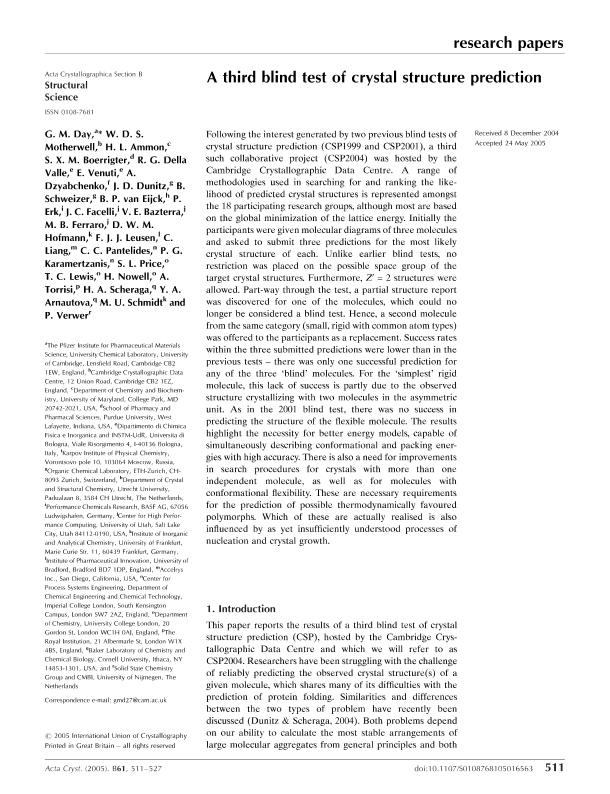Artículo
A third blind test of crystal structure prediction
Day, G.M.; Motherwell, W.D.S.; Ammon, H.L.; Boerrigter, S.X.M.; Della Valle, R.G.; Venuti, E.; Dzyabchenko, A.; Dunitz, J.D.; Schweizer, B.; Van Eijck, B.P.; Erk, P.; Facelli, Julio C.; Bazterra, V.E.; Ferraro, Marta Beatriz ; Hofmann, D.W.M.; Leusen, F.J.J.; Liang, C.; Pantelides, C.C.; Karamertzanis, P.G.; Price, S.L.; Lewis, T.C.; Nowell, H.; Torrisi, A.; Scheraga, H.A.; Arnautova, Yelena A.; Schmidt, M.U.; Verwer, P.
; Hofmann, D.W.M.; Leusen, F.J.J.; Liang, C.; Pantelides, C.C.; Karamertzanis, P.G.; Price, S.L.; Lewis, T.C.; Nowell, H.; Torrisi, A.; Scheraga, H.A.; Arnautova, Yelena A.; Schmidt, M.U.; Verwer, P.
 ; Hofmann, D.W.M.; Leusen, F.J.J.; Liang, C.; Pantelides, C.C.; Karamertzanis, P.G.; Price, S.L.; Lewis, T.C.; Nowell, H.; Torrisi, A.; Scheraga, H.A.; Arnautova, Yelena A.; Schmidt, M.U.; Verwer, P.
; Hofmann, D.W.M.; Leusen, F.J.J.; Liang, C.; Pantelides, C.C.; Karamertzanis, P.G.; Price, S.L.; Lewis, T.C.; Nowell, H.; Torrisi, A.; Scheraga, H.A.; Arnautova, Yelena A.; Schmidt, M.U.; Verwer, P.
Fecha de publicación:
05/2005
Editorial:
Wiley Blackwell Publishing, Inc
Revista:
Acta Crystallographica Section B-Structural Science
ISSN:
0108-7681
Idioma:
Inglés
Tipo de recurso:
Artículo publicado
Clasificación temática:
Resumen
Following the interest generated by two previous blind tests of crystal structure prediction (CSP1999 and CSP2001), a third such collaborative project (CSP2004) was hosted by the Cambridge Crystallographic Data Centre. A range of methodologies used in searching for and ranking the likelihood of predicted crystal structures is represented amongst the 18 participating research groups, although most are based on the global minimization of the lattice energy. Initially the participants were given molecular diagrams of three molecules and asked to submit three predictions for the most likely crystal structure of each. Unlike earlier blind tests, no restriction was placed on the possible space group of the target crystal structures. Furthermore, Z′ = 2 structures were allowed. Part-way through the test, a partial structure report was discovered for one of the molecules, which could no longer be considered a blind test. Hence, a second molecule from the same category (small, rigid with common atom types) was offered to the participants as a replacement. Success rates within the three submitted predictions were lower than in the previous tests - there was only one successful prediction for any of the three 'blind' molecules. For the 'simplest' rigid molecule, this lack of success is partly due to the observed structure crystallizing with two molecules in the asymmetric unit. As in the 2001 blind test, there was no success in predicting the structure of the flexible molecule. The results highlight the necessity for better energy models, capable of simultaneously describing conformational and packing energies with high accuracy. There is also a need for improvements in search procedures for crystals with more than one independent molecule, as well as for molecules with conformational flexibility. These are necessary requirements for the prediction of possible thermodynamically favoured polymorphs. Which of these are actually realised is also influenced by as yet insufficiently understood processes of nucleation and crystal growth. © 2005 International Union of Crystallography Printed in Great Britain - All rights reserved.
Archivos asociados
Licencia
Identificadores
Colecciones
Articulos(IFIBA)
Articulos de INST.DE FISICA DE BUENOS AIRES
Articulos de INST.DE FISICA DE BUENOS AIRES
Citación
Day, G.M.; Motherwell, W.D.S.; Ammon, H.L.; Boerrigter, S.X.M.; Della Valle, R.G.; et al.; A third blind test of crystal structure prediction; Wiley Blackwell Publishing, Inc; Acta Crystallographica Section B-Structural Science; 61; 5; 5-2005; 511-527
Compartir
Altmétricas



